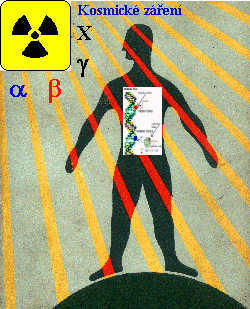 |
§ BEAMS
OF LIFE § and/or N DEATH N Radiation as an important natural phenomenon Influence of ionizing radiation on life Use of radiation in diagnostics and therapy Lecturer:
RNDr. Vojtech
Ullmann |
| AstroNuclPhysics ® Nuclear Physics - Astrophysics - Cosmology - Philosophy |
 |
§ BEAMS
OF LIFE § and/or N DEATH N Radiation as an important natural phenomenon Influence of ionizing radiation on life Use of radiation in diagnostics and therapy Lecturer:
RNDr. Vojtech
Ullmann |
- lecture syllabus -
Radiation - an important natural phenomenon
| RADIATION
(in general) |
= | Energy
transfer through space "at a distance" by means of physical fields or microparticles |
| In addition to radiation energy, there is also the transfer of matter and information |
| Energy transfer mechanism: | |
| Time changes of field strength | Particle motion |
| ( Waves - electromagnetic, gravitational ) | (electrons b, a -particles, protons, neutrons, ...) |
| ë cosmuscular-wave dualism ì | |
Radiation
propagation in space:
¨ Vacuum - free wave propagation and particle motion - according to the law of inertia
¨ Substance
environment - partial
passage
-
scattering -
absorption - re-emission ® attenuation of
radiation
energy-dependent
® change of radiation spectrum
| (structured) Energy transfer |
® mediates ® | Information transfer |
Radiation
transmits informations :
¨ About the source emitting
radiation (its nature, composition,
"strength", possibly variability, etc.)
¨ About the
material environment through which the radiation passes
(density, thickness, chemical composition of the material
environment)
| Encoding information in : | Decoding of information : | |
| Radiation intensity | ® | Radiation detection |
| Energy distribution | ® | Radiation spectrometry |
Radiation
helps to reveal :
¨ The secret of
the composition of matter
¨ The structure
and evolution of the universe (especially stars
and galaxies, global cosmological issues)
¨ Anatomical
structure and physiological processes in living organisms
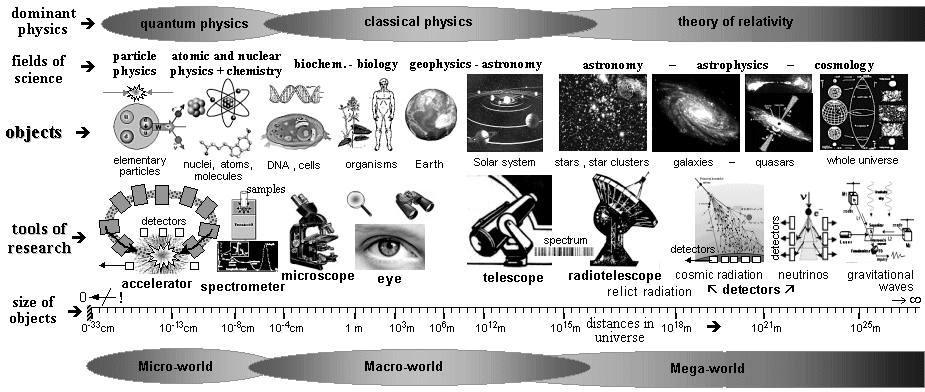
Radiation
energy:
¨ Helps to treat
some diseases, especially cancer
¨ It is used in
radiation technologies
Light - A source of visual information about the world
What is light?
Both theories are partly right - they describe two different aspects of one phenomenon :
Remarkable property of light: independence of the speed of light (c = 300,000 km/s) on the mutual movement of the source and the observer Þ Einstein's special theory of relativity .
Radiation in general :
However: Corpuscularly - wave dualism !
The rest mass m0 of the radiation quantum decides :
m0 > 0 Þ corpuscular ; m0 = 0 Þ wave
Corpuscular radiation:
Wave radiation:
Energy and radiation effects :
Ionizing radiation:
| It is radiation whose quantums have such a high energy that they are able to eject electrons from the atomic shell and thus cause ionization of substances. |
For conventional
types of radiation photon (X, g), the electron (b-), and a is taken
as the energy limit of ionizing
radiation the energy of quant 5 keV . |
Physics of ionizing radiation - radiation physics - radiology - dosimetry
RADIOLOGY = radiation science in general ; in medicine: RADIOLOGY = use of radiation for diagnosis and therapy
The
physics of ionizing radiation is
also known as radiation physics or radiophysics.
It covers a wide range of issues :
¨ Mechanisms of radiation
formation
¨ Physical
properties of radiation
¨ Interaction of
radiation with matter (including radiobiological
effects)
¨ Detection and
spectrometry of radiation
¨ Mathematical
analysis and evaluation of results
A special area of radiation physics is radiological physics , dealing with physical aspects of radiation in
medicine. Dosimetry of ionizing radiation is a field of radiation physics,
which deals with the measurement and effects of radiation on
substances in relation to the types and properties of radiation -
substance interaction and the amount of radiation absorbed in the
substance (absorbed energy - "dose") - §5.1 "Effects of radiation on matter". The studied substance is mainly living
tissue, model measurements of doses and dose rates are
performed in water, air and in special dosimetric
phantoms.
Radiology
-
radiation in biology and medicine
From the etymological point of view, the word radiology
generally means the science of radiation.
However, historical developments have narrowed
and specialized its significance. Radiology is
now a science of the importance and use of radiation in
medicine and biology, a medical field that uses ionizing
radiation for diagnosis and therapy. It mainly includes three
main special fields :
l X-ray
diagnostics, also called radiodiagnostics *)
(§3.2 "X-ray diagnostics") .
l Radiotherapy
(§3.6 "Radiotherapy") .
l Nuclear
medicine (Chapter 4 "Radioisotope
scintigraphy")
*) During the development, other diagnostic
methods that do not use ionizing radiation were included
in radiodiagnostics - ultrasonic sonography (see Ultrasound sonography), nuclear magnetic resonance (Nuclear magnetic resonance) and thermography (Thermography).
Radiobiology
deals with the biological effects of ionizing radiation (see
§5.2 "Biological effects of
ionizing radiation") - a field
on the border of radiation physics and biology.
Emergence and sources of radiation : (natural - artificial )
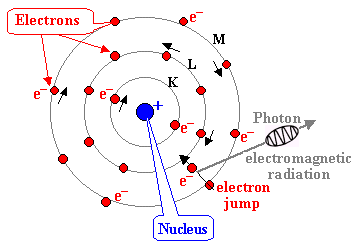
Radioactivity :
| A physical phenomenon in which atomic nuclei transform spontaneously, whereby ionizing radiation is emitted . |
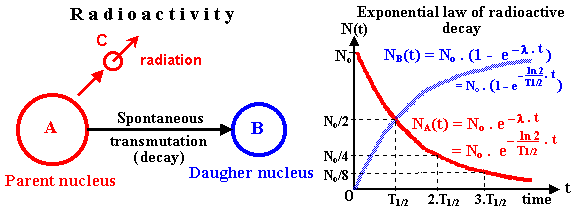
Radioactivity a:
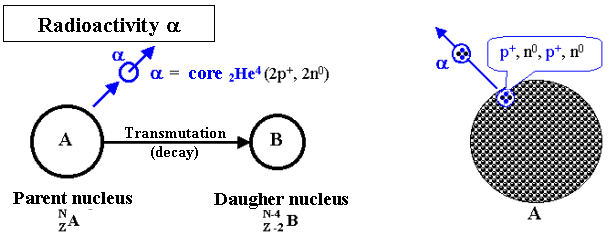
Occurs only
in the heaviest nuclei - in the area of uranium and transuranium.
Radiation a has a very short range
in the substance - a limited importance.
Radioactivity b - :

The electron b-
is formed in the nucleus by the transformation of the neutron: n0
® p+
+ e- + n
Radioactivity b + :
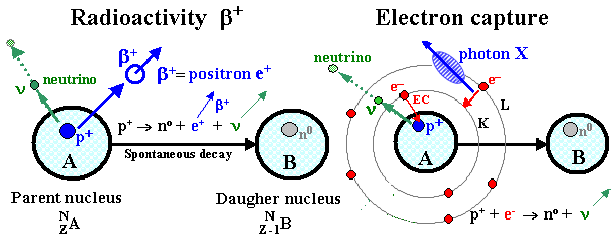
The positron b+
is formed in the nucleus by the transformation of a proton: p+
® n0
+ e+ + n
The spectrum of radiation b is continuous - the energy of transformation is divided between the particle b and the neutrino n .
Internal mechanism of beta
radioactivity :
Transmutation of quarks "d" and "u"
inside neutrons and protons due to a weak interaction
mediated by intermediate bosons W -,+,
which then decay into electrons or positrons and neutrinos.
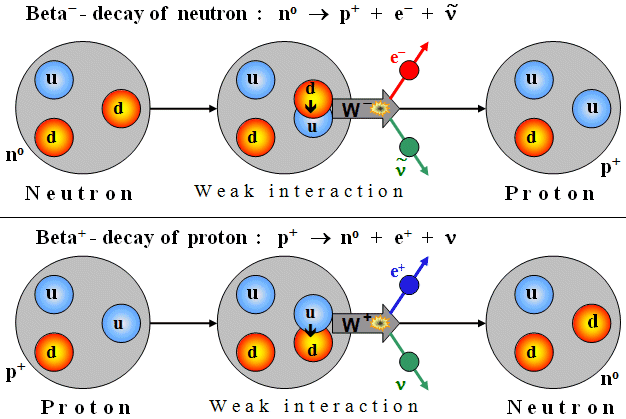
| Radiation g : |
 Gamma radiation is
high-energy electromagnetic radiation generated by
deexcitation of excited levels of the atomic nucleus . Gamma radiation is
high-energy electromagnetic radiation generated by
deexcitation of excited levels of the atomic nucleus . In radioactivity it is the deexcitation of excited levels of the daughter nucleus formed after radioactive transformation . |
| Gamma
radiation of non-nuclear origin In addition to deexcitation of excited energy levels in atomic nuclei, g radiation is also produced by annihilation of positrons with electrons ,and also other particles and antiparticles, as well as by interactions of high-energy particles (g radiation of energies of the order GeV, TeV and higher). The category of radiation g also includes braking radiation generated by the impact of high-energy electrons on a target. |
Basic properties of gamma radiation: - Penetration
Interaction of ionizing radiation with matter :
Interaction of alpha and beta radiation

Interaction of gamma radiation with matter in four ways :

1. Photo effect 2. Compton scattering 3. Formation of
electron-positron pairs 4. Nuclear photo effect
Effects of ionizing radiation in matter and life
Influence of ionizing radiation on
matter :
On elements: Ionization of atoms ® recombination on
the same atoms - no chemical effects.
On compounds: Ionization of atoms ®
chemical reactions ® radiolysis of
compounds ® reactions of radicals ® formation of new
compounds.
The "gateway" to chemical reactions opens - the more
complex the compound, the more diverse the radiation-induced
reactions.
Influence
of ionizing radiation on living tissue:
Cells - basic units of living
organisms

Influence
of ionizing radiation on cells and DNA :
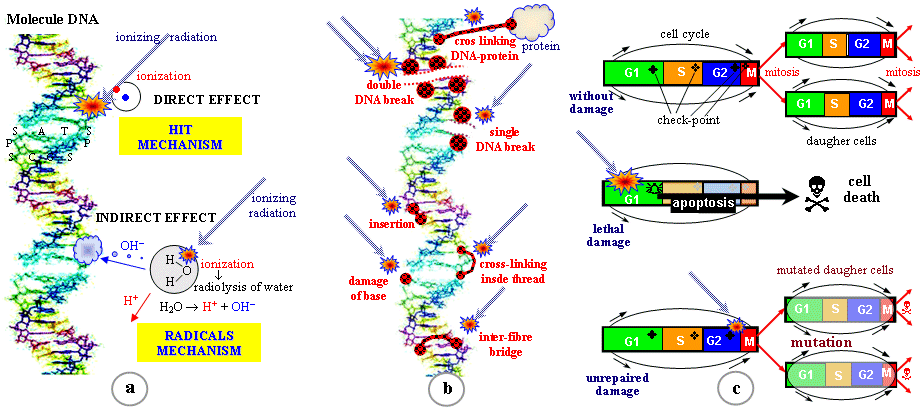
Radiobiological effects at the subcellular level. a)
Interventional and radical mechanism of the effect of radiation
on living tissue.
Above: When radiation enters the
DNA macromolecule, ionization and a direct destructive effect
occur. Bottom: Ionizing radiation interacts with
the water molecule, radiolysising of water occurs: H2O
® H +
+ OH - - formation of free
radicals . Highly reactive H + and OH -
radicals attack complex organic molecules and chemically change
them. DNA is disrupted in the nuclei of cells.
b) Different types of DNA damage due to
radiation and chemical influences (rough schematic
representation). c)
Radiation effects during the cell cycle.

Schematic representation of significant processes and their time
sequence in the effects of ionizing radiation on living tissue.
Small doses
Low ion density ® small
number of DNA damage ® high probability of repair
mechanisms for DNA repair
® stochastic effects

High
doses of radiation
High ion density ® large number of damages ® repair mechanisms fail ® part of the cells dies
® deterministic effects ® radiation
sickness
Linear-quadratic (LQ) model : N = N0.e-(a.D+b.D2) T -ln (N/N0) = a.D + b.D2 - linear-quadratic dependence

Some deviations from the LQ model of dose-response of biological
effect.
a) Multiple
interactions of radiation with
cells lead to the presence of members with a higher exponent of
dose D . b) The bystander effect slightly increases the total number of damaged cells
(decreases the fraction of surviving cells). c)
In the area of low doses, a relatively increased cell sensitivity
- hyperradiosensitivity - is observed on the graph of the surviving fraction of
cells .
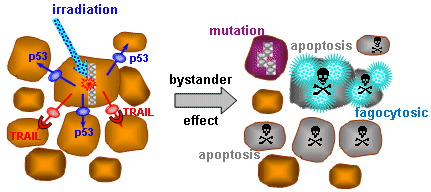 |
Bystander effect. Radiation damage to a single cell can induce damage to some surrounding cells, that have not been irradiated. |
| Noxiously effects of ionizing radiation Þ the need for radiation protection ! |
Use of ionizing radiation in medicine
Diagnostics
X-ray trans-illumination of the organism - image of
tissue density - X-ray diagnostics :

Application of radioindicator ® detection of outgoing gamma radiation ® diagnostics of structure and function of organs
- Radionuclide scintigraphy - nuclear medicine : + In vitro laboratory methods
- radioimmunoassay (RIA)
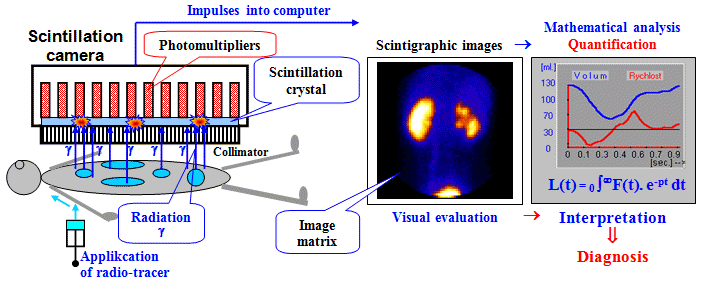
Radiotherapy
Targeted irradiation of pathological tissue with a large
(lethal) dose of radiation ® destruction of tumor cells .
Basic task: Achieve the largest possible dose at the target site
with the least possible damage to the surrounding tissues .
Teletherapy - external beam radiation rays
("remote")
- Isocentric radiotherapy - radiation from several
angles :
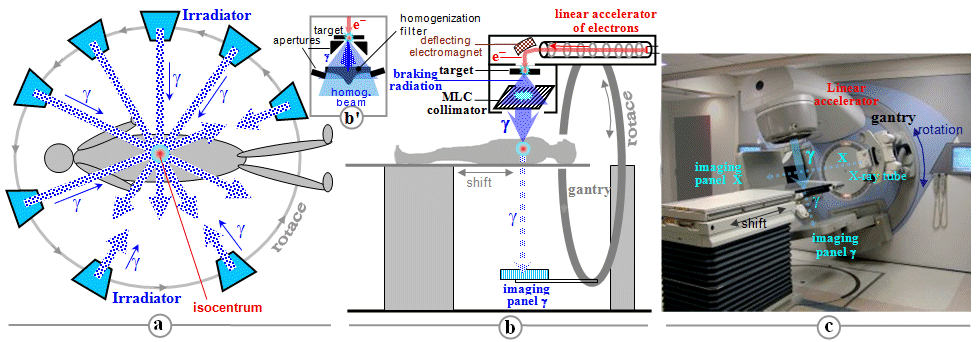
Modern methods for
high-precision radiotherapy
- stereotactic radiotherapy SBRT :

- hadron radiotherapy : irradiation with
accelerated protons (or a-particles, or carbon nuclei)
and the use of peak Bragg curves (indicating the
depth dependence of the effective dose) at the end of the braking
path of the particle :

- Brachytherapy - introducing emitters "near", into or around
tumors :
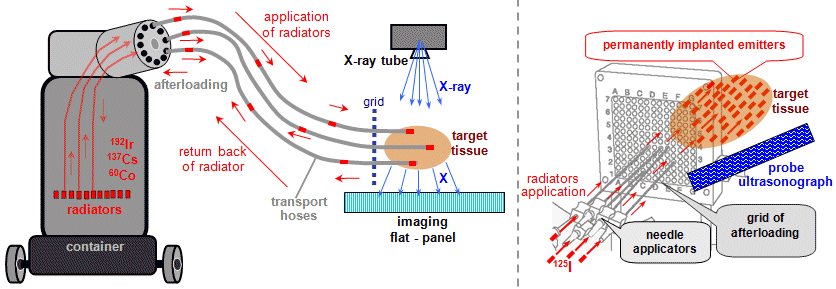
- Radioisotope therapy open emitters beta or alpha - the "most close
brachytherapy" - up close at cellular level (e.g. thyroid treatment radioiodine 131I, radionuclide
therapy of metastases, haematologic therapy radionuclide
synovectomy)

Radiation and life in the natural environment
Ionizing radiation in the natural environment:

Cosmic radiation probably played an important role in the origin and evolution of life, in at least two ways :
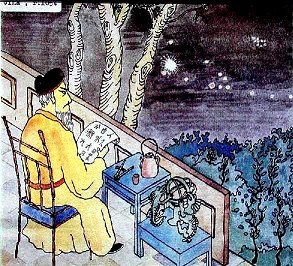 |
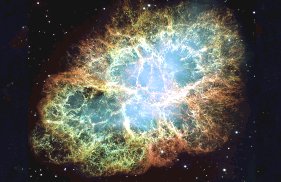 |
| Supernova explosion observed in 1054 in China | Today, a Crab Nebula containing a pulsar inside - a rapidly rotating neutron star - is observed at that place |
| Massive flashes of cosmic rays - a deadly danger to life ! |
Conclusion
§ Rays of life - beneficial effects of radiation
- Without radiation there
would be no life - origin, evolution, maintenance of life
- Radiation as a source of energy and information
- Use of radiation for diagnostics and therapy in medicine
N Rays of death - harmful and destructive effects of
radiation
- Criminal misuse of nuclear energy for war
purposes
- Improper and careless handling of ionizing radiation sources -
radiation accidents
- Risks from natural radiation sources
| Unjustified radiophobia when working with radiation : |
| With erudite work with knowledge of the matter and adherence to the principles of radiation protection, it can be achieved that working with ionizing radiation is no more dangerous and harmful than working with any other materials, machines and equipment . |